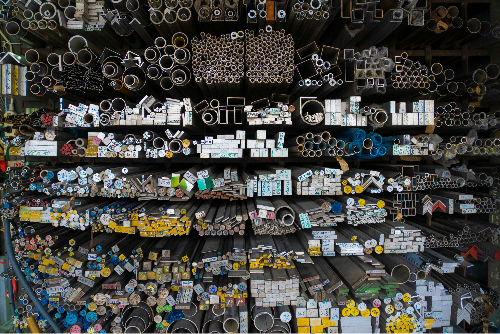Construction Logistics in Transition: More Efficient, Sustainable, and Cost-Effective — with Involvement from Suppliers and Carriers
- news and press

- May 12
- 4 min read
The construction sector is facing a significant logistical challenge. As sustainability and cost-efficiency become increasingly important, the delivery of construction materials often still relies on traditional and inefficient methods. This isn't just a matter for construction companies alone — suppliers and carriers are integral parts of a supply chain that urgently needs to evolve.

Construction companies lead, suppliers and carriers follow
In construction logistics, contractors and subcontractors essentially dictate transport flows. They place orders with suppliers, who are then responsible for organizing the actual delivery of materials. This supply chain — already under pressure — is becoming increasingly complex due to rising CO₂ reduction requirements and mandatory emissions reporting. At the same time, logistics costs are soaring, often reaching up to 15% of the total construction budget.
Change is no longer optional — it’s essential. And this transformation must be collaborative. Optimizing construction logistics isn’t something one party can do alone; it requires cooperation from all players in the chain: construction companies, suppliers, and carriers alike.
The long and inefficient journey of construction materials
A basic look at the supply chain reveals its inefficiencies. Construction materials follow a lengthy path: from raw materials to manufacturers, then to wholesalers, followed by delivery to the customer — either directly to the construction site or first into local storage. From there, materials are often transported yet again to the building site.
This series of handoffs results in delays, increased costs, and a heavy environmental toll. On average, trucks delivering to construction sites or wholesalers operate at only 60% capacity — and return trips are nearly always empty. That means a true average load factor of only 30%. Additionally, vehicles making deliveries in urban areas spend over 60% of their time parked — often while waiting for an available unloading spot. The conclusion is clear: current transportation methods are costly, inefficient, and unsustainable.
Major savings for suppliers
A key opportunity for improvement lies at the source — in how suppliers manage storage and deliveries. Many still align their warehousing capacity with production output rather than actual customer demand. This results in unnecessary square meters and high fixed personnel costs.
By shifting to more dynamic, demand-driven storage and distribution — and potentially outsourcing storage to logistics hubs — suppliers can significantly reduce overhead. In fact, real-world cases show that suppliers can save up to 50% on warehouse space and staffing costs. This enhances flexibility while reducing financial burden.
Smarter transport planning saves up to 40%
Transport can also be drastically optimized. By ensuring trucks are fully loaded and delivering to a single location — such as a construction hub — transport becomes far more efficient. Instead of multiple small deliveries to scattered building sites, consolidated shipments go to one centralized hub. From there, materials are distributed in the right quantities, at the right times, directly to the site.
Construction hubs act as intelligent links within the supply chain. With flexible storage capacity, suppliers no longer have to worry about space constraints on site. Furthermore, with chain-wide visibility, deliveries from multiple suppliers can easily be combined — especially when they’re headed to the same destination. This leads to transport savings of up to 40%.
Emission-free deliveries — even without electric fleets
Stricter regulations on urban transport, particularly zero-emission zones, are a growing concern. Not all carriers are yet equipped with electric or hydrogen-powered vehicles. But that doesn’t have to be a roadblock.
By delivering to a hub just outside the city, carriers can transfer goods to electric vehicles managed by the hub operator. This enables them to meet client delivery requirements while ensuring the final leg of the journey — the “last mile” — is emission-free.
The benefits for carriers extend beyond emissions. With fewer stops, shorter delays, and no need to search for unloading zones, their time becomes significantly more productive. More deliveries per day, fewer empty trips, and higher load factors make the business more sustainable and profitable.
What’s the bottom line?
If these logistics improvements are implemented holistically, the benefits are substantial:
Up to 35% reduction in total logistics costs(including transportation, warehousing, and hub usage)
Up to 50% reduction in CO₂ emissions during transportthanks to fewer trips, fuller loads, and zero-emission last-mile delivery
Full-chain insight is essential for success
To unlock these benefits, full visibility across the supply chain is essential. Without transparency and coordination between all links, efficient planning and load consolidation are impossible. This is where Qonnected Logistics comes in.
Qonnected has developed a cutting-edge logistics platform that offers full chain insight and integration. The platform connects seamlessly with a nationwide network of 15 construction hubs and 8 city logistics hubs across the Netherlands, enabling efficient, smart, and sustainable logistics planning.
With this platform, construction logistics becomes not only manageable but also measurably more efficient, sustainable, and cost-effective. Qonnected is ready to calculate your potential savings — and even guarantees a 35% cost reduction in your construction logistics process.
Want to know how a Construction Hub can benefit your supply chain?Visit www.qonnectedlogistics.nl or contact us for a free logistics assessment.


_edited.png)
_edited.png)
_edited.png)


_edited.png)
_edited_edited.png)









_edited.png)



Tolson Transport is a trusted name in Australia’s logistics industry, known for professionalism, reliability, and efficiency. We offer comprehensive side loader container transport and freight solutions, ensuring safe, on-time deliveries. With a focus on customer satisfaction and modern equipment, Tolson Transport remains a dependable partner for seamless logistics across the country.
Drayage intermodal services have been a game-changer for my online shoe store. Before, managing orders and logistics was overwhelming and time-consuming. Now, the fulfillment team takes care of warehousing, order processing, and shipping, reducing errors and delays. Their specialized knowledge in handling footwear means fewer returns and damaged goods. This has enhanced my customer experience and allowed me to scale up my business without worrying about fulfillment logistics.